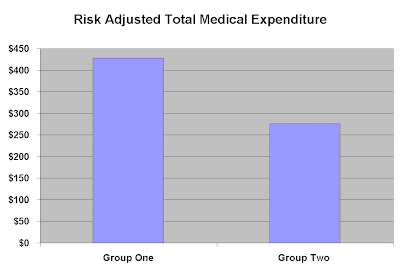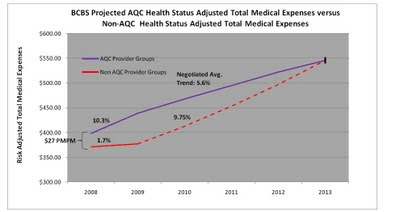Health Care for All, an advocacy group that played a substantive role in passing health care reform here in Massachusetts, has come out in favor of a health insurance premium freeze. They cite the case of Sarah Higginbotham, who says her biweekly take-home pay for a part time job at a church used to be $900, but has dwindled to $164 since she now has a family plan and health insurance premiums have risen by double digits each year.
Premium increases are caused by a combination of increased unit prices, increased utilization, increased intensity of services, and increased burden of illness. Price increases could be substantially decreased or eliminated quickly, although that might take price controls. Lifestyle change can lower burden of illness, but not by 2012. Increased utilization can be changed – but takes some time. Increased intensity of service sometimes represents innovations that can save lives (such as today's New England Journal, which has an article showing that screening CT scans for those at high risk for lung cancer can save lives. More on that in a future post.)
Most insurance funded by large insurers is “self insured,” so that the stated premium is irrelevant – as the employer pays the bills. However, smaller employers need to purchase “fully funded” insurance –so the level of stated premium is the price paid by the employer and employee. A premium freeze would be a big break for small employers and nonprofits. But it won’t be easy to achieve, and lower premium increases will only be sustainable with genuine change in the health care delivery system.
Health insurers in Massachusetts could offer a premium freeze on fully-insured health plans by one of the following methods:
Lower Profits:
Lower Profits:
Some insurers have high profit margins, and could endure a year of a premium freeze just be accepting lower profits. However, Massachusetts insurers generally have low profit margins.
Lower administrative costs:
Lower administrative costs:
Administrative costs for the nonprofit regional health plans here are also on the low side nationally. Administrative costs represent less than 10% of total premium, and the claims must be paid – so that wouldn’t likely achieve enough savings to allow for a premium freeze.
Lower provider payments The Attorney General’s report documents that some providers receive higher unit payments, and also have higher risk-adjusted total medical expense costs. However, each health plan would need to reopen negotiations with multiple providers to get lower prices. The market has determined those prices – so it won’t be easy to change these quickly. Remember also that we don’t have providers with huge profit margins. So, significant provider pay cuts will likely cause job loss and attempts to cost-shift to payers that have less leverage.
Lower medical costs Health plans have been performing medical management for years – and these programs can make a difference, especially for high risk patients. Health management programs aren’t cheap, though, and they take a substantial amount of time to pay off. I don’t imagine that plans to increase medical management or to improve healthy lifestyles of Massachusetts residents will make huge difference in health care costs in 2012.
Cost-shifting Insurers could raise premiums elsewhere to cover the lost revenue from a premium freeze. Again, the market wouldn’t make this easy – and some national insurers might leave the state.
Risk-shifting Insurers could avoid insuring the sickest patients – and could therefore avoid premium increases. However, regulation of the small group market makes it difficult for health plans to selectively enroll healthy patients.
Lower provider payments The Attorney General’s report documents that some providers receive higher unit payments, and also have higher risk-adjusted total medical expense costs. However, each health plan would need to reopen negotiations with multiple providers to get lower prices. The market has determined those prices – so it won’t be easy to change these quickly. Remember also that we don’t have providers with huge profit margins. So, significant provider pay cuts will likely cause job loss and attempts to cost-shift to payers that have less leverage.
Lower medical costs Health plans have been performing medical management for years – and these programs can make a difference, especially for high risk patients. Health management programs aren’t cheap, though, and they take a substantial amount of time to pay off. I don’t imagine that plans to increase medical management or to improve healthy lifestyles of Massachusetts residents will make huge difference in health care costs in 2012.
Cost-shifting Insurers could raise premiums elsewhere to cover the lost revenue from a premium freeze. Again, the market wouldn’t make this easy – and some national insurers might leave the state.
Risk-shifting Insurers could avoid insuring the sickest patients – and could therefore avoid premium increases. However, regulation of the small group market makes it difficult for health plans to selectively enroll healthy patients.
So, I’m not optimistic we’ll achieve a health insurance premium freeze in Massachusetts in 2012. However, hats off to Health Care for All for humanizing the impact of health care premium increases. I think this conversation can help push meaningful change in health care delivery that could lower future health care cost increases.
 6:53 PM
6:53 PM
 indigo
indigo








